RESEARCH
Our research has three main directions:
1) Studying fundamental light-matter interactions, laser-initiated mechanisms from photolysis to crystal disruptions, the role of feedback in nano/micro-pattern forming systems, and the potential for control in the self-organizational physics.
2) Armed with a deep knowledge of optical interaction dynamics, developing novel laser-based micro\nano fabrication approaches, engineering new 2D and 3D architectures, and closely related to this direction, 3) exploring new functionalities enabled with novel fabrication and operation modes. Below are several highlights:
![]()
Laser nanofabrication inside silicon with spatial beam modulation and anisotropic seeding
Nature Communications 15, 5786 (2024) (pdf)
Nanofabrication in silicon, one of the most critical materials for modern technology, has been limited exclusively to its surface. Conventional lithography methods cannot penetrate the wafer surface without altering it, whereas emerging laser-based subsurface or in-chip fabrication techniques are constrained to resolutions greater than 1 μm. In addition, available methods lack the capability to position or modulate structures with sub-micron precision deep inside the wafer. The fundamental difficulty of breaking these dimensional barriers is two-fold, i.e., complex nonlinear effects inside the wafer and the inherent diffraction limit for laser light.
Here, my research group overcomes these challenges by exploiting spatially-modulated lasers and anisotropic feedback from preformed subsurface structures. We introduce a ground-breaking nanofabrication paradigm, achieving resolution far below the diffraction limit. The methosd enables controlled nanofabrication capability deep inside silicon, enabling buried nanostructures of feature sizes as small as 100 ± 20 nm, sub-wavelength and multi-dimensional control; thereby advancing the state-of-the-art by an order-of-magnitude. By employing spatial beam modulation, we drive unique nonlinear feedback mechanisms and plasmonic interactions within silicon’s bulk, enabling subwavelength modulation and unprecedented 3D nanoscale functionality. Key advances include seeding-based interactions that propagate nanostructures, laser polarization as a novel tool for controlling nanoscale symmetry, and the first in-chip nanophotonics functionality. These have significant implications for electronics, Si-photonics, photovoltaics, and MEMS/NEMS, — industries collectively exceeding $500 billion in annual revenue. This work paves the way for exciting opportunities in 3D nanophotonics, multi-functional chips, and enhanced electronic-photonic integration, toward a new wave of innovation in semiconductor technologies.
![]()
Breaking crosstalk limits to dynamic holography using orthogonality of high-dimensional random vectors
Nature Photonics 13, 251 (2019) (pdf)
 Holography is considered as the best candidate for 3D projections, but the realization of complex 3D images had been elusive. The fundamental difficulty is in storing all the information necessary to depict a complex 3D image in the 2D form of the hologram, without letting projections at different depths contaminate each other. This is due to the crosstalk between different images at different projection depths. In this work, we solved this fundamental problem, and achieved the first method to enable true-to-life 3D holographic projection. We created holograms that form with full-depth-control and without crosstalk, producing large-volume, high-density, dynamic 3D projections with 1000 image planes simultaneously, improving the state-of-the-art for number of simultaneously created planes without crosstalk by two orders of magnitude. Thus, for the first time, we achieve the projection of a closed-surface object, with its front, middle and back projected simultaneously from a single hologram, similar to the iconic holograms of Star Wars. Incidentally, this invention was not initially motivated by the desire to create 3D displays, but by the drive to control the laser projection and hence energy delivery to and from the semiconductor wafers. Indeed, the emerging capability has significant potential to project the laser pulse energy with precise control inside the material and enable the exploration of unique 3D laser fabrication modalities within semiconductors.
Holography is considered as the best candidate for 3D projections, but the realization of complex 3D images had been elusive. The fundamental difficulty is in storing all the information necessary to depict a complex 3D image in the 2D form of the hologram, without letting projections at different depths contaminate each other. This is due to the crosstalk between different images at different projection depths. In this work, we solved this fundamental problem, and achieved the first method to enable true-to-life 3D holographic projection. We created holograms that form with full-depth-control and without crosstalk, producing large-volume, high-density, dynamic 3D projections with 1000 image planes simultaneously, improving the state-of-the-art for number of simultaneously created planes without crosstalk by two orders of magnitude. Thus, for the first time, we achieve the projection of a closed-surface object, with its front, middle and back projected simultaneously from a single hologram, similar to the iconic holograms of Star Wars. Incidentally, this invention was not initially motivated by the desire to create 3D displays, but by the drive to control the laser projection and hence energy delivery to and from the semiconductor wafers. Indeed, the emerging capability has significant potential to project the laser pulse energy with precise control inside the material and enable the exploration of unique 3D laser fabrication modalities within semiconductors.
![]()
In-chip microstructures and photonic devices fabricated by nonlinear laser lithography deep inside silicon
Nature Photonics 11, 639–645 (2017) (pdf)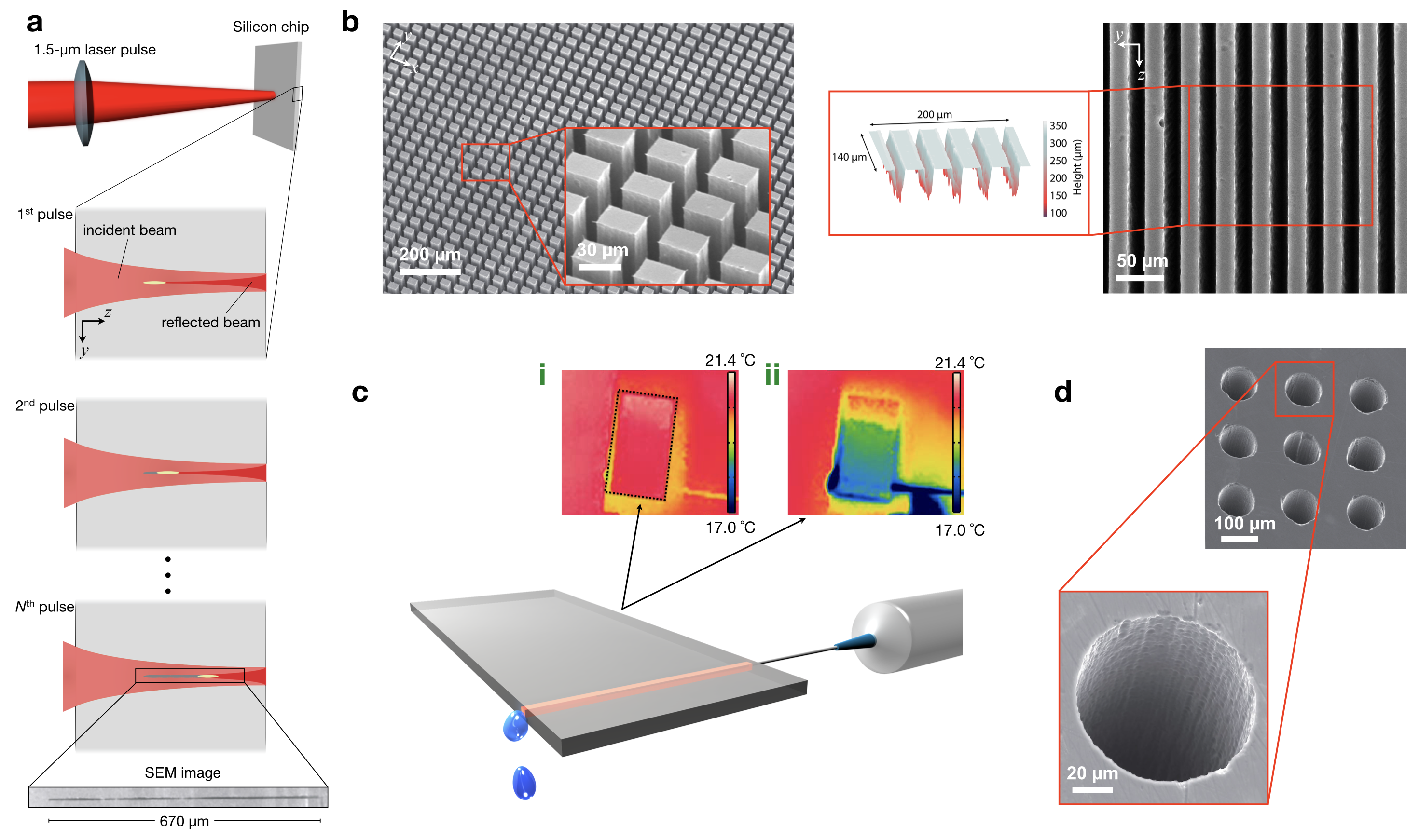
Silicon is an excellent material for microelectronics and integrated photonics, with untapped potential for mid-infrared optics. Despite broad recognition of the importance of the third dimension, current lithography methods do not allow the fabrication of photonic devices and functional microelements directly inside silicon chips. Even relatively simple curved geometries cannot be realized with techniques like reactive ion etching. Embedded optical elements, electronic devices and better electronic–photonic integration are lacking. Here, we demonstrate laser-based fabrication of complex 3D structures deep inside silicon using 1-μm-sized dots and rod-like structures of adjustable length as basic building blocks. The laser-modified Si has an optical index different to that in unmodified parts, enabling the creation of numerous photonic devices. Optionally, these parts can be chemi- cally etched to produce desired 3D shapes. We exemplify a plethora of subsurface—that is, ‘in-chip’—microstructures for microfluidic cooling of chips, vias, micro-electro- mechanical systems, photovoltaic applications and photonic devices that match or surpass corresponding state-of-the-art device performances.
 Femtosecond laser written waveguides deep inside silicon
Femtosecond laser written waveguides deep inside silicon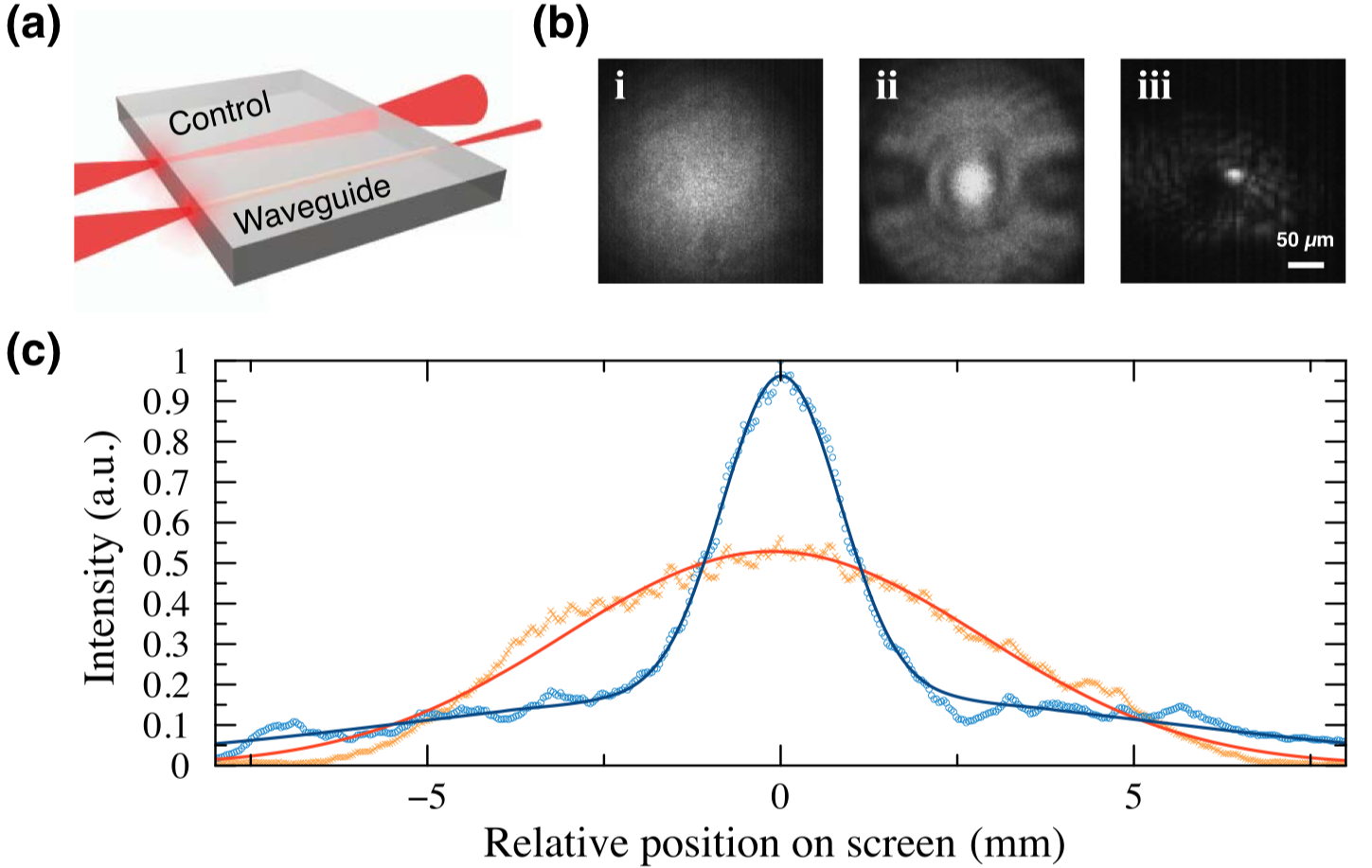
Optics Letters 42, 3028-3031 (2017)
Photonic devices that can guide, transfer, or modulate light are highly desired in electronics and integrated silicon (Si) photonics. Here, we demonstrate for the first time, to the best of our knowledge, the creation of optical waveguides deep inside Si using femtosecond pulses at a central wavelength of 1.5 μm. To this end, we use 350 fs long, 2 μJ pulses with a repetition rate of 250 kHz from an Er-doped fiber laser, which we focused inside Si to create permanent modifications of the crystal. The position of the beam is accurately controlled with pump-probe imaging during fabrication. Waveguides that were 5.5 mm in length and 20 μm in diameter were created by scanning the focal position along the beam propagation axis. The fabricated waveguides were characterized with a continuous-wave laser operating at 1.5 μm.
 Rich complex behaviour of self-assembled nanoparticles far from equilibrium
Rich complex behaviour of self-assembled nanoparticles far from equilibrium
Nature Communications 8, 14942 (2017) (Please see Dr. Serim Ilday’s Simply Complex Lab, leading this effort.)
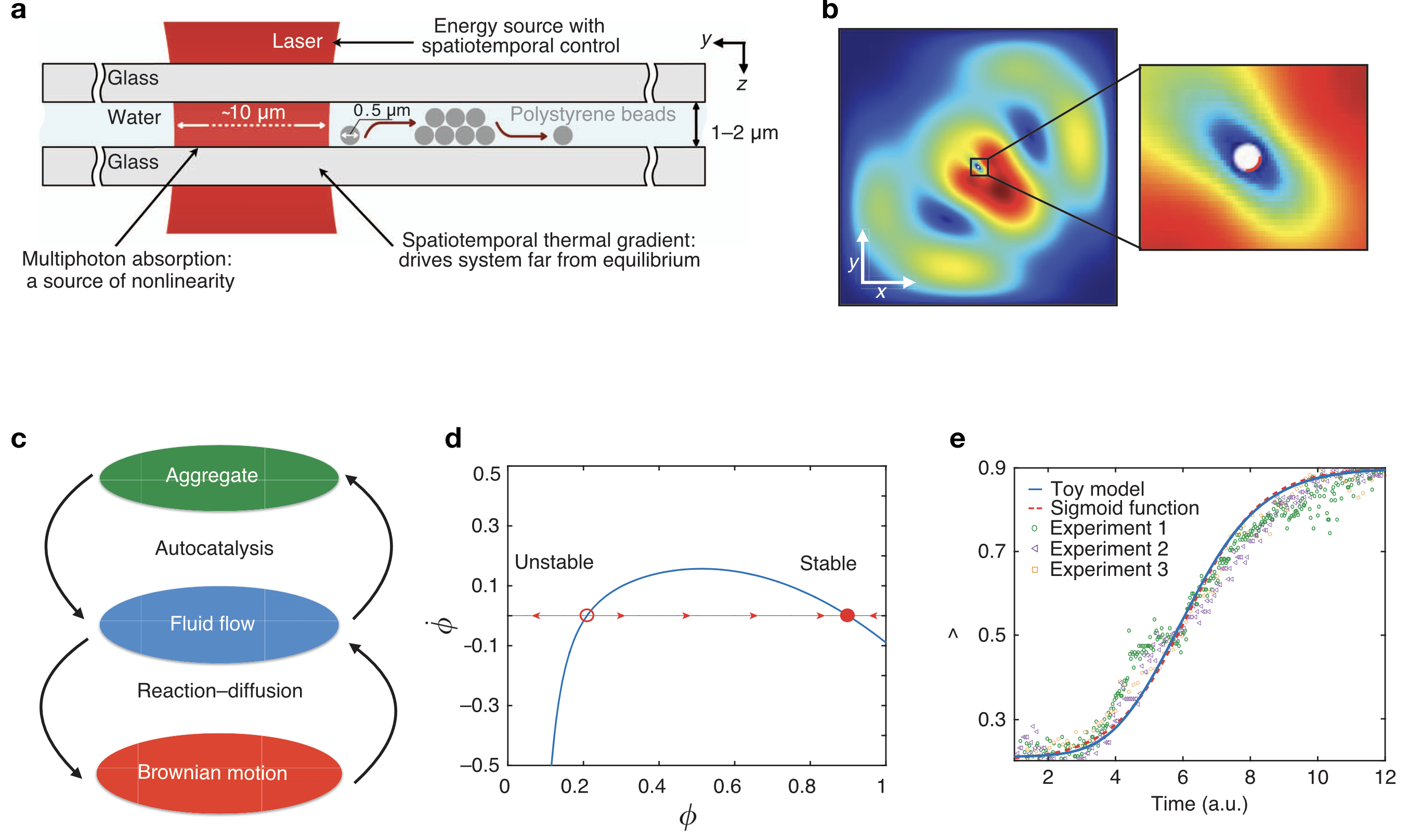 A fundamental question at the interface between physics and biology remains open: what are the minimum requirements for emergence of complex behaviour from nonliving systems? Here, we shed light on this question and report complex behaviour of tens to thousands of colloidal nanoparticles in a system designed to be as plain as possible: the system is driven far from equilibrium by ultrafast laser pulses that create spatiotemporal temperature gradients, inducing Marangoni flow that drags particles towards aggregation; strong Brownian motion, used as source of fluctuations, opposes aggregation. Nonlinear feedback mechanisms naturally arise between flow, aggregate and Brownian motion, allowing fast external control with minimal intervention. Consequently, complex behaviour arises, analogous to those seen in living organisms, whereby aggregates self-sustain, self-regulate, self-replicate, self-heal, all within seconds. Aggregates can comprise only one pattern or bifurcated patterns can coexist, compete, endure or perish.
A fundamental question at the interface between physics and biology remains open: what are the minimum requirements for emergence of complex behaviour from nonliving systems? Here, we shed light on this question and report complex behaviour of tens to thousands of colloidal nanoparticles in a system designed to be as plain as possible: the system is driven far from equilibrium by ultrafast laser pulses that create spatiotemporal temperature gradients, inducing Marangoni flow that drags particles towards aggregation; strong Brownian motion, used as source of fluctuations, opposes aggregation. Nonlinear feedback mechanisms naturally arise between flow, aggregate and Brownian motion, allowing fast external control with minimal intervention. Consequently, complex behaviour arises, analogous to those seen in living organisms, whereby aggregates self-sustain, self-regulate, self-replicate, self-heal, all within seconds. Aggregates can comprise only one pattern or bifurcated patterns can coexist, compete, endure or perish.
Fundamental laser-mater interactions at the quantum mechanical level
Photodissociation of ozone from 321 to 329 nm: relative yields of O(3P2) with O2(X 3Σg–), O2(a 1Δg) and O2(b 1Σg+)
J. Phys. Chem. A. 117, 12011 (2013)
Photodissociation of ozone 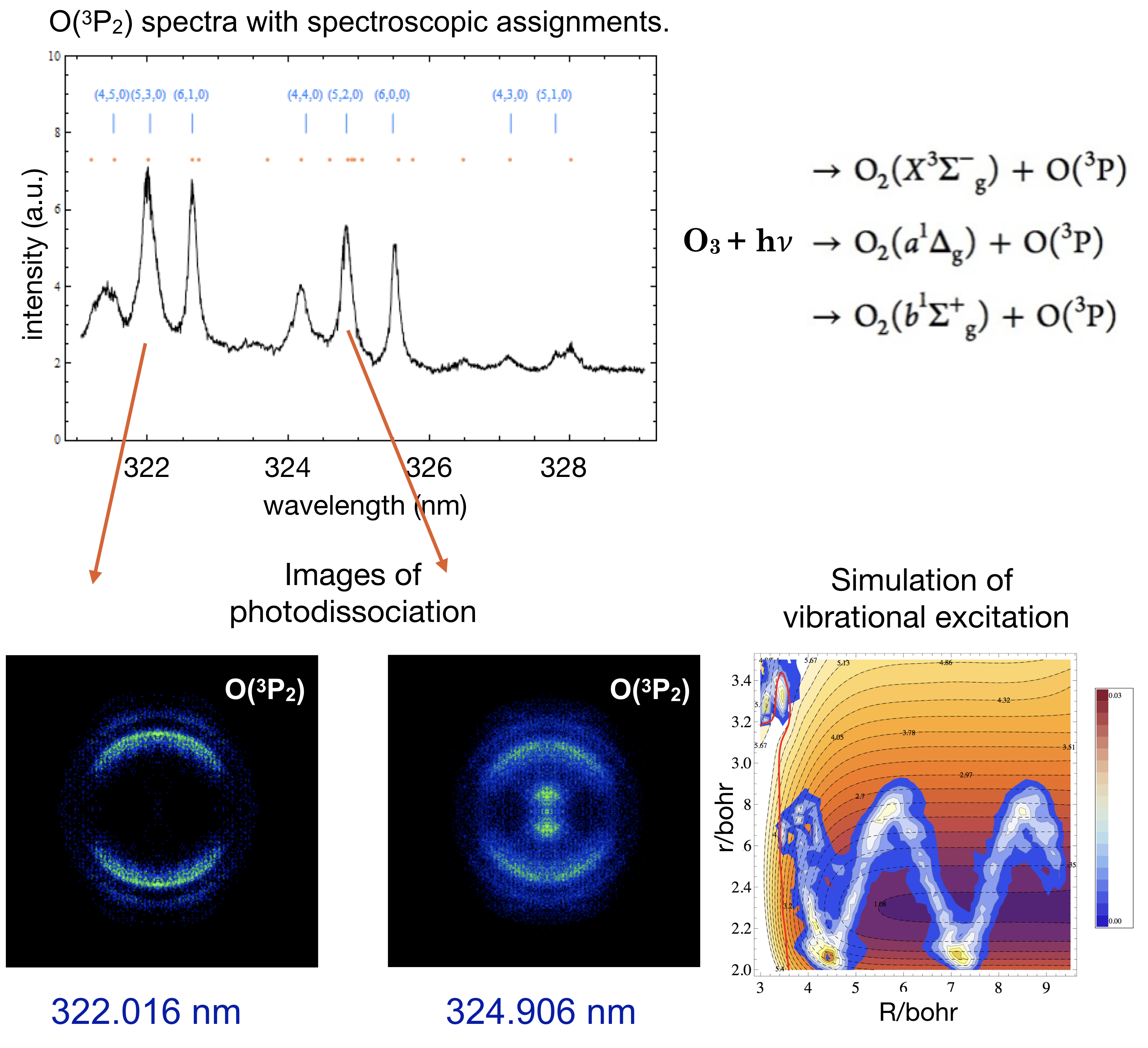 molecule is one of the most critical events for our understanding of atmospheric processes. However, details of the light matter interaction physics is still lacking. Here, we provide direct imaging of oxygen atoms from the laser photodissociation event to shed more light on the responsible mechanisms. We use the Velocity Map Imaging Technique, which provides deep insights into the nature of laser-initiated reactions both with the ability to show us a snapshot of the event and by testing our theoretical calculations. Product imaging of O(3P2) atoms following dissociation of ozone has been used to determine the relative yields of three product channels O(3P2) + O2. All three channels are prominent at all wavelengths investigated. O2 vibrational distributions for each channel and each wavelength are also estimated assuming Boltzmann rotational distributions. Averaged over wavelength, the yields of the O(3P2) + O2(X 3Σg–), O(3P2) + O2(a 1Δg), and O(3P2) + O2(b1Σg+) channels are 0.36, 0.31, and 0.34. Photofragment distributions in the spin-allowed channel O(3P) + O2(X 3Σg–) are compared with the results of quantum mechanical calculations on the vibronically coupled potential energy surfaces of the singlet states B (optically bright) and R (repulsive). The experiments suggest that considerably more vibrational excitation and less rotational excitation occur than predicted by the quantum calculations. The rotational distributions, adjusted to fit experimental images, suggest that the dissociation takes place from a more linear configuration than the Franck–Condon bending angle of 117°. The dissociation results in a positive value of the anisotropy parameter, β, both in the experiments and in calculations. Calculations indicate that both nonadiabatic transitions and intersystem crossings substantially reduce β below the nominal value of 2.
molecule is one of the most critical events for our understanding of atmospheric processes. However, details of the light matter interaction physics is still lacking. Here, we provide direct imaging of oxygen atoms from the laser photodissociation event to shed more light on the responsible mechanisms. We use the Velocity Map Imaging Technique, which provides deep insights into the nature of laser-initiated reactions both with the ability to show us a snapshot of the event and by testing our theoretical calculations. Product imaging of O(3P2) atoms following dissociation of ozone has been used to determine the relative yields of three product channels O(3P2) + O2. All three channels are prominent at all wavelengths investigated. O2 vibrational distributions for each channel and each wavelength are also estimated assuming Boltzmann rotational distributions. Averaged over wavelength, the yields of the O(3P2) + O2(X 3Σg–), O(3P2) + O2(a 1Δg), and O(3P2) + O2(b1Σg+) channels are 0.36, 0.31, and 0.34. Photofragment distributions in the spin-allowed channel O(3P) + O2(X 3Σg–) are compared with the results of quantum mechanical calculations on the vibronically coupled potential energy surfaces of the singlet states B (optically bright) and R (repulsive). The experiments suggest that considerably more vibrational excitation and less rotational excitation occur than predicted by the quantum calculations. The rotational distributions, adjusted to fit experimental images, suggest that the dissociation takes place from a more linear configuration than the Franck–Condon bending angle of 117°. The dissociation results in a positive value of the anisotropy parameter, β, both in the experiments and in calculations. Calculations indicate that both nonadiabatic transitions and intersystem crossings substantially reduce β below the nominal value of 2.
O(1D) + N2O reaction: NO vibrational and rotational distribution
J. Phys. Chem. A 114, 11292 (2010)
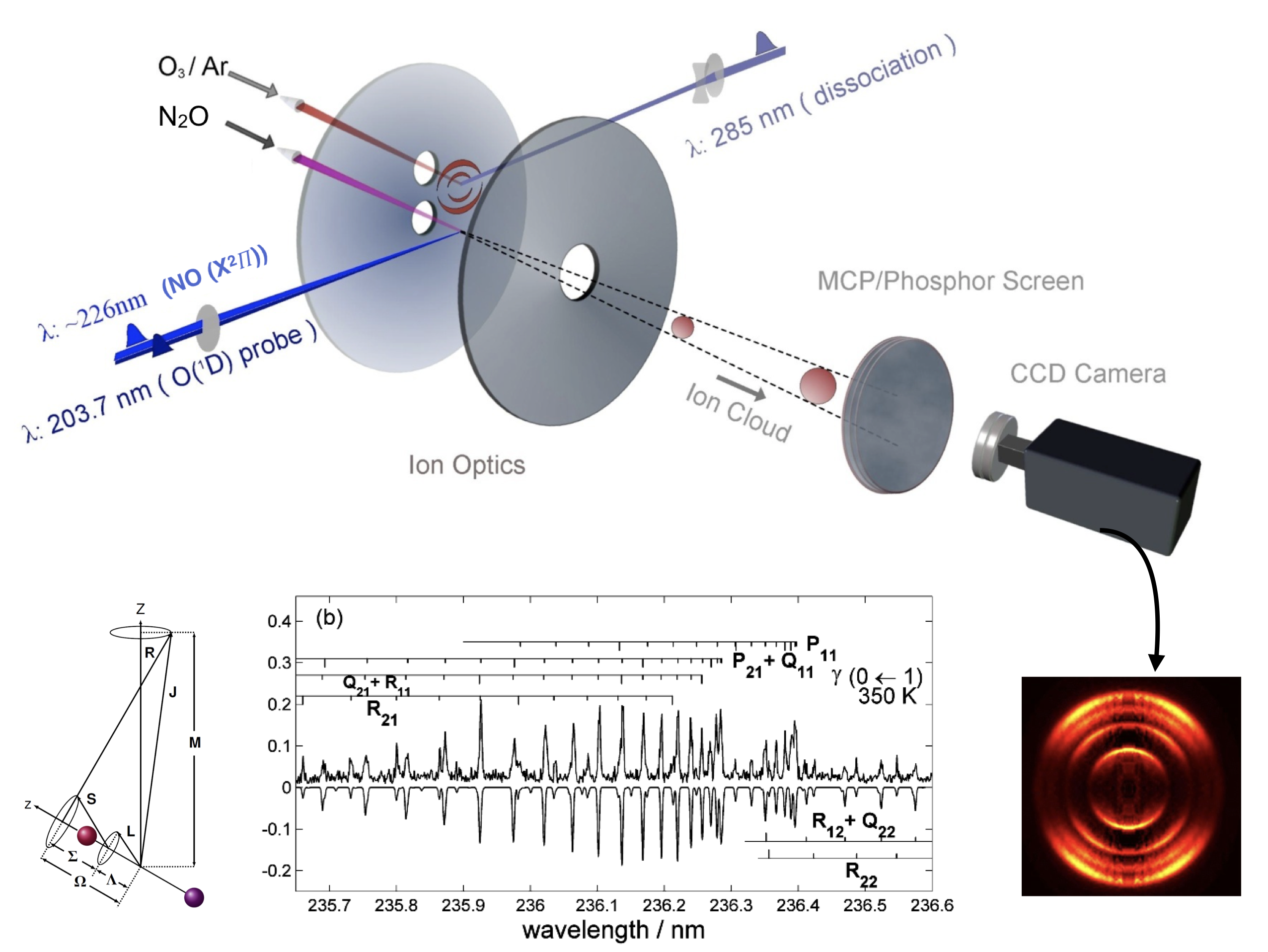 The O(1D) + N2O reaction is important because the branching ratio between its two channels is fundamental to the steady-state concentration of ozone. Here, we study the O(1D) + N2O → 2NO(X2Π) channel in detail with a molecular beam experiment, providing spectroscopic assignments and kinetic information for the reaction. The precursor O(1D) atoms were created by laser initiated photodissociation of O3 at 266 nm, and the NO(X2Π) molecules from the reaction were detected with 1+1 Resonance Enhanced Multiphoton Ionization (REMPI) over the 220−246 nm wavelength range. The resulting spectra was used to extract rotational and vibrational distributions of NO(X2Π) molecules, with detailed molecular spectroscopy. The product rotational distribution is found to be characterized by a rotational temperature of 4500 K for all observed bands, v = 0−9. An inverted vibrational distribution is also observed. An explanation is suggested considering two paths for the reaction, one producing a nearly statistical vibrational distribution for low velocity collisions and the second producing an inverted distribution due to high velocity collisions.
The O(1D) + N2O reaction is important because the branching ratio between its two channels is fundamental to the steady-state concentration of ozone. Here, we study the O(1D) + N2O → 2NO(X2Π) channel in detail with a molecular beam experiment, providing spectroscopic assignments and kinetic information for the reaction. The precursor O(1D) atoms were created by laser initiated photodissociation of O3 at 266 nm, and the NO(X2Π) molecules from the reaction were detected with 1+1 Resonance Enhanced Multiphoton Ionization (REMPI) over the 220−246 nm wavelength range. The resulting spectra was used to extract rotational and vibrational distributions of NO(X2Π) molecules, with detailed molecular spectroscopy. The product rotational distribution is found to be characterized by a rotational temperature of 4500 K for all observed bands, v = 0−9. An inverted vibrational distribution is also observed. An explanation is suggested considering two paths for the reaction, one producing a nearly statistical vibrational distribution for low velocity collisions and the second producing an inverted distribution due to high velocity collisions.
Novel applications of photonic integration
Portable microfluidic integrated plasmonic platform for pathogen detection
Scientific Reports 5, 9152 (2015)
Integrating microfluidic platforms with optical imaging systems combines the advantages of lab-chip platforms with the benefits of optical technologies. In particular, photonics and plasmonics technologies can be used for developing reliable, accurate, easy-to-use biosensor platforms. Optically integrated lab-chip devices can also serve as affordable platforms by utilizing single-use, disposable microchips for point-of-care testing. Here, we present a portable, multiplexed, inexpensive microfluidic-integrated surface plasmon resonance platform that rapidly detects and quantifies bacteria, i.e., Escherichia coli (E. coli) and Staphylococcus aureus (S. aureus). The platform presented reliable capture and detection of E. coli at concentrations in a wide range (105 to 3.2×107 CFUs/mL). The multiplexing and specificity capability of the platform was also tested with S. aureus samples. The technology is applicable to capture and detect other pathogens at the POC and primary care settings.
with optical imaging systems combines the advantages of lab-chip platforms with the benefits of optical technologies. In particular, photonics and plasmonics technologies can be used for developing reliable, accurate, easy-to-use biosensor platforms. Optically integrated lab-chip devices can also serve as affordable platforms by utilizing single-use, disposable microchips for point-of-care testing. Here, we present a portable, multiplexed, inexpensive microfluidic-integrated surface plasmon resonance platform that rapidly detects and quantifies bacteria, i.e., Escherichia coli (E. coli) and Staphylococcus aureus (S. aureus). The platform presented reliable capture and detection of E. coli at concentrations in a wide range (105 to 3.2×107 CFUs/mL). The multiplexing and specificity capability of the platform was also tested with S. aureus samples. The technology is applicable to capture and detect other pathogens at the POC and primary care settings.
Nanoplasmonic quantitative detection of intact viruses from unprocessed whole blood
ACS Nano 7, 4733 (2013)
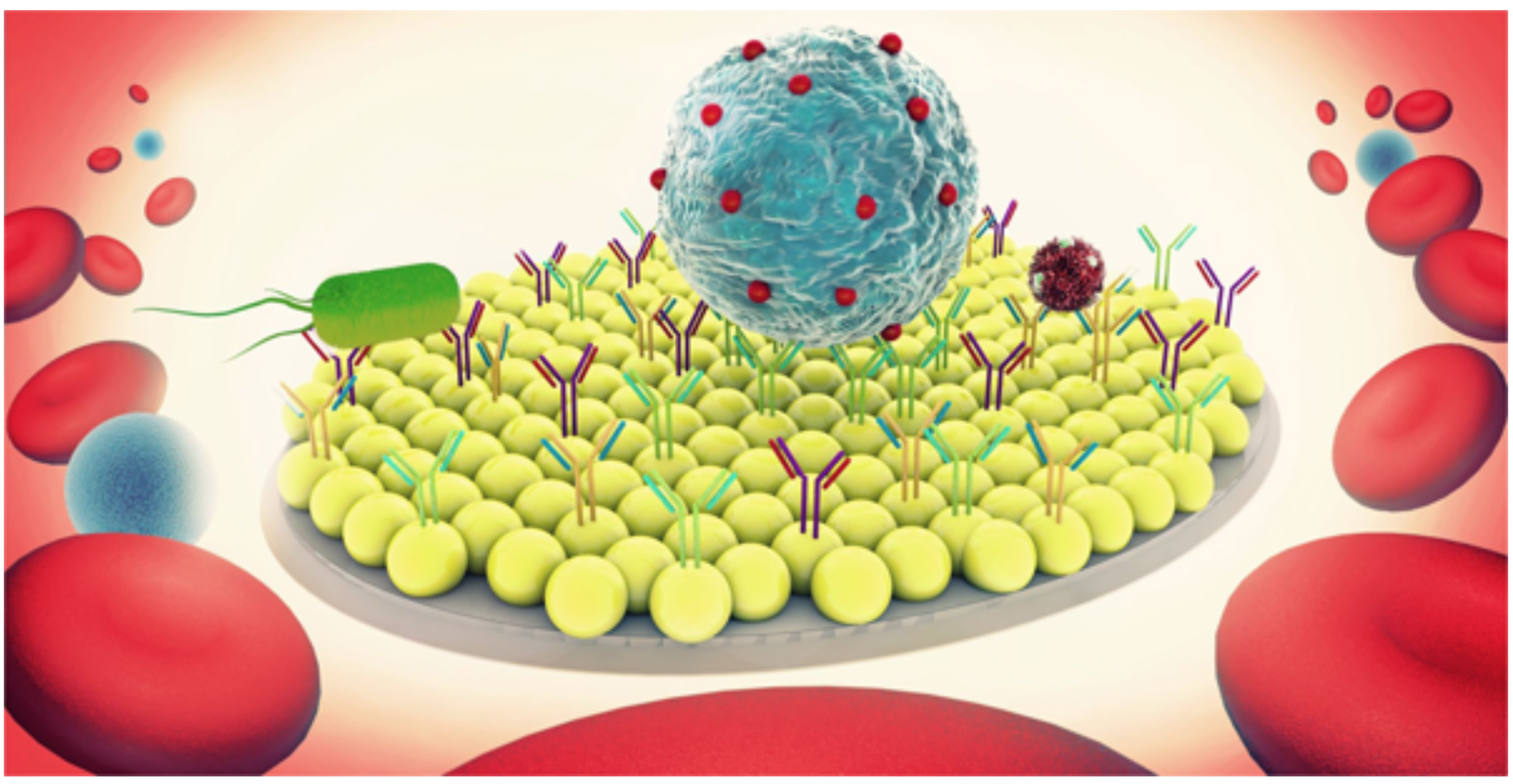 To the best of our knowledge, no viral load technology adaptable to the point-of-care (POC) settings exists today due to critical technical and biological challenges. Here, we present for the first time a broadly applicable technology for quantitative, nanoplasmonic-based intact virus detection at clinically relevant concentrations. The sensing platform is based on unique nanoplasmonic properties of nanoparticles utilizing immobilized antibodies to selectively capture rapidly evolving viral subtypes. We demonstrate the capture, detection, and quantification of multiple HIV subtypes (A, B, C, D, E, G, and subtype panel) with high repeatability, sensitivity, and specificity down to 98 copies/mL using spiked whole blood samples and clinical discarded HIV-infected patient whole blood samples validated by the gold standard, i.e., RT-qPCR. The platform is able to capture intact viruses with high efficiency using immuno-surface chemistry approaches directly from whole blood samples, without any sample preprocessing steps; and is accurate, repeatable, and reliable. The technology can be broadly adapted to detect other pathogens, holding promise to be implemented at diverse medical settings.
To the best of our knowledge, no viral load technology adaptable to the point-of-care (POC) settings exists today due to critical technical and biological challenges. Here, we present for the first time a broadly applicable technology for quantitative, nanoplasmonic-based intact virus detection at clinically relevant concentrations. The sensing platform is based on unique nanoplasmonic properties of nanoparticles utilizing immobilized antibodies to selectively capture rapidly evolving viral subtypes. We demonstrate the capture, detection, and quantification of multiple HIV subtypes (A, B, C, D, E, G, and subtype panel) with high repeatability, sensitivity, and specificity down to 98 copies/mL using spiked whole blood samples and clinical discarded HIV-infected patient whole blood samples validated by the gold standard, i.e., RT-qPCR. The platform is able to capture intact viruses with high efficiency using immuno-surface chemistry approaches directly from whole blood samples, without any sample preprocessing steps; and is accurate, repeatable, and reliable. The technology can be broadly adapted to detect other pathogens, holding promise to be implemented at diverse medical settings.
